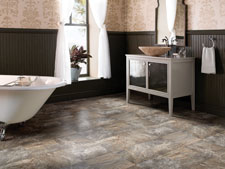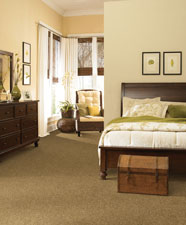As the saying goes, every cloud has a silver lining and this rings true in floor covering. A decidedly negative economic state found a ray of light in the  resurgent sales of resilient flooring and carpet. On the decline for much of the early 21st century, these two categories have been consistently gaining market share throughout the financial downturn and beckoned sales in a climate where other categories suffered mightily.
resurgent sales of resilient flooring and carpet. On the decline for much of the early 21st century, these two categories have been consistently gaining market share throughout the financial downturn and beckoned sales in a climate where other categories suffered mightily.
“Resilient is on the rebound,” said David Sheehan, vice president of resilient business at Mannington Mills, “due in large part to the movement of the consumer toward products that are practical and pragmatic in today’s economy.”
Beaulieu of America echoed positive growth on behalf of the consumer’s new perspective. “We are encouraged by the uptick in carpet sales,” said Patricia Flavin, senior vice president of marketing. “Consumers have come to realize they are living the ‘new normal’ and expect great product, service and value.”
The buzz phrase, “new normal,” is seen and heard in the news on a daily basis, but what is the new normal in floor covering? As Flavin outlined, it draws the greatest value per dollar in terms of life cycle, customer service, ease of installation, technology and innovation.
“Showing a positive return on investment is essential in today’s market and is surely playing a major part in the flooring choice decision,” said Gary Finseth, vice president of Tarkett Residential. He also cited factors like performance, life cycle, maintenance costs, aesthetics and modularity as some of the draws for purchasing resilient flooring. “Resilient flooring provides more value for the homeowner’s hard-earned dollar than its real counterparts.”
Allen Cubell, Armstrong’s vice president of resilient and laminate, called resilient flooring one of the most economical choices one can make for the home. “It offers the widest variety of quality levels and prices and it can be used on all levels of the house. It’s quiet and comfortable underfoot, water-resistant, easy to clean and to maintain.” It takes visual cues from authentic flooring materials but leaves the inconvenience of sealing, crack repairs and refinishing for the birds.
Carpet and resilient found particular favor in the remodeling segment as new home construction flat-lined. “While the mortgage market remains tight, replacement flooring is in demand,” Flavin explained. “People are fixing up their current homes instead of moving and carpet, they often find, is an excellent replacement flooring.”
Technological advances
Buyers aren’t going for resilient flooring and carpet simply because it is lower priced and easier to care for than hardwood or tile. Technological advances have brought the categories a long way in the last five years.
“Bringing new technologies and improved attributes whether in design, installation or maintenance, prospects for resilient are very positive,” Cubell said. “Armstrong’s Alterna offers endless design possibilities in a new premium tile that realistically mimics the natural material down to a unique design variation which ensures there are few repeats in the floor’s pattern, making each floor distinct.”
“Armstrong’s Alterna offers endless design possibilities in a new premium tile that realistically mimics the natural material down to a unique design variation which ensures there are few repeats in the floor’s pattern, making each floor distinct.”
Many of Armstrong’s newest offerings in resilient—203 SKUs of sheet and tile in 2009— have changed the game for installation. Offerings like Luxe Plank, a floating vinyl plank that can be repositioned after installation, has opened doors for do-it-yourselfers and novice builders.
“The big news is ease of installation and options, whether you’re talking fiber-glass, felt-back or StrataMax, which offers faster, less costly and environmentally friendly installation with no underlayments or adhesives required,” Cubell said.
Tarkett’s advances have added visual legitimacy to the LVT category. “Innovations in style and design, such as our GroutFil option in our Permastone lines, gives the appearance of grouted tile because it is grouted tile,” Finseth said. “Now you have value and product design that you would be hard-pressed to tell wasn’t real unless you got down on the floor and touched it.”
Carpet has also progressed by leaps and bounds. “As homeowners come back into the market for new floor covering, they are discovering carpet has changed,” Flavin explained. “Technology and innovations in fiber construction, stain resistance, as well as proprietary features such as odor reduction and antimicrobial protection as we have at Beaulieu with Magic Fresh and Silver Release, have positively changed decades-old perceptions about carpet.”
David Duncan, Mohawk’s vice president of marketing, also cited proprietary innovation for creating value. “Smartstrand with DuPont Sorona carpets are the perfect example,” he said. “Here, one can select superior durability, lifetime stain protection, inherent softness and environmental friendliness.” Mohawk’s fiber is made of 37% corn sugar, a renewably sourced material, and helped establish a new fiber classification by the Federal Trade Commission, triexta.
A feel-good story
Environmental and social accountability contributes to the end user’s gravitation toward resilient flooring and carpet. Renewable and recycled resources are on the consumer’s radar with growing concern for the future of her family and her family’s family. In addition to ease of care and maintenance, both flooring options improve indoor air quality (IAQ).
 Many resilient companies offer commercial-grade sheet flooring specifically designed for healthcare applications. Armstrong and Mannington’s commercial divisions offer renew- able-sourced products that have strengthened the position of resilient flooring in the market, (FCNews, May 31/June 7.)
Many resilient companies offer commercial-grade sheet flooring specifically designed for healthcare applications. Armstrong and Mannington’s commercial divisions offer renew- able-sourced products that have strengthened the position of resilient flooring in the market, (FCNews, May 31/June 7.)
Fiber advances are also noteworthy. “Carpet is one of the most sustainable products available for the home today,” said Emily Morrow, director of color, style and design for Shaw. “Shaw carpet and padding contains recycled content, can be recycled and improves indoor air quality, too.” She also mentioned the savings on energy bills from insular properties. “Carpet has an R factor that is measurable, saving the homeowner money on heating or cooling.”
-Emily Hooper
